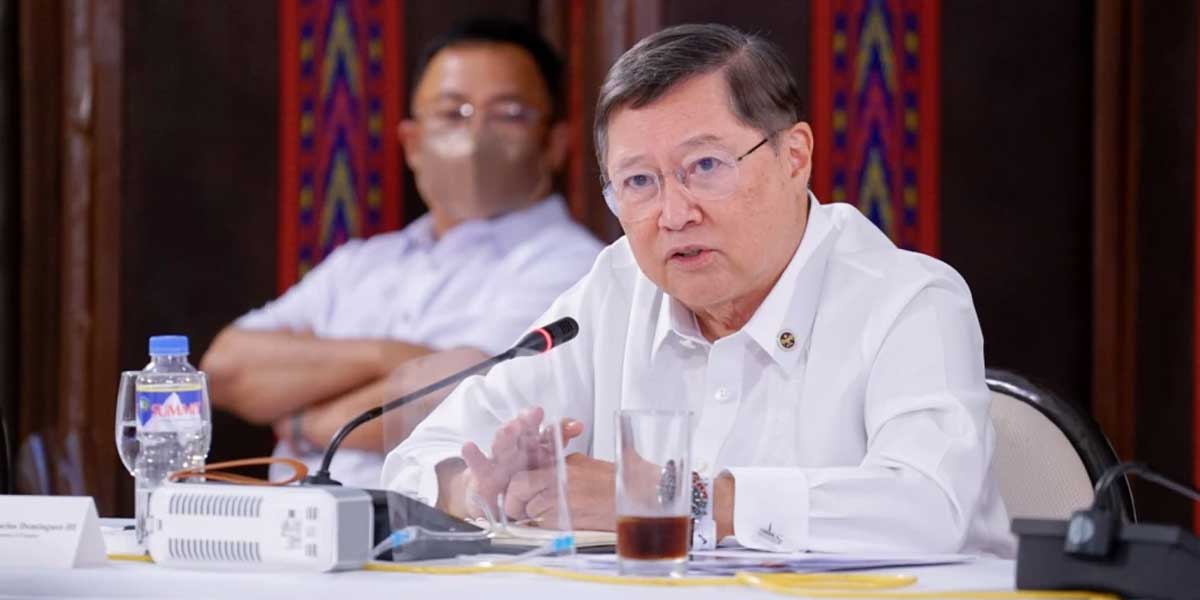
Finance Secretary Carlos Dominguez III said Monday the Duterte administration will continue its sustainable and prudent borrowing strategy in 2021 and 2022 to support its COVID-19 response measures and economic recovery program while ensuring the government’s strong cash position amid the pandemic.
This debt management strategy that President Duterte has pursued long before the pandemic struck last year has allowed the government to reverse his predecessors’ anemic spending on infrastructure and dramatically increase investments in social services to a three-year average that is higher than the combined average annual expenditure of the past four administrations, Dominguez said.
As a result, the government was able to bring down poverty incidence t0 16.7 percent in 2018 from 23.5 percent in 2015, which translates into six million Filipinos lifted out of poverty in the first four years of the Duterte presidency.
“Our financing programs for 2021 and 2022 reflect the same strategy. We will continue with our sustainable and prudent borrowing to fund both economic investments and the pandemic response,” Dominguez said.
“The financing also considers provisioning for buffers to ensure a strong cash position amidst the pandemic. With abundant liquidity in our financial system, we will continue borrowing more from our domestic sources,” he added.
Dominguez explained to legislators during this morning’s briefing by selected government officials before the House ways and means committee that incurring debt even during this pandemic is the right thing to do for the government if this will help fund the people’s needs and generate a higher level of economic activity necessary to keep the economy afloat.
“However, we must use our borrowings in a prudent manner. We should use them to beef up our health requirements and to generate productive economic activity. If we do not do these things, the economy will collapse even further. We have to spend wisely and that’s exactly what we have been doing.”
The committee chaired by Albay Rep. Joey Salceda held the briefing in relation to its deliberations on several bills seeking the creation of an oversight body to monitor and oversee the government’s borrowings–and possibly set a ceiling on the country’s indebtedness.
“Through the length of this pandemic, the Duterte administration never lost sight of the demands of fiscal responsibility,” Dominguez said.
He reiterated his call for the Executive Branch and the Legislature to work together to achieve a solid recovery from the pandemic “by keeping our deficit and debt ratios within reasonable levels,” so that the country’s finances will remain “in great shape for the next administration and the future generation of Filipinos.”
Dominguez said the Duterte administration’s debt management program, supported by improved revenue collections through bold tax reforms and prudent fiscal management, enabled it to bring down the Philippines’ debt-t0-GDP (gross domestic product) ratio to a historic low of 39.6 percent, which means that its heavy investments on infrastructure and social services have paid off.
“Resources have been allocated to ensure that our economy consistently outgrew our debt.”
Dominguez said this “exemplary financial and debt management” also brought the Philippines’ credit rating to the highest levels it has ever achieved, which, when the pandemic struck, gave the government easy access to very concessional borrowing rates and terms extended by the Philippines’ bilateral and multilateral development partners.
The Philippines’ high credit ratings secured during the Duterte administration also enabled the government to float its bonds in the international capital markets at low rates and tight spreads.
When the COVID-19 pandemic necessitated unplanned spending to reinforce the country’s health system, purchase medical equipment, and procure vaccines, this temporarily pushed up the deficit level to 7.6 percent last year, or almost double the threshold that the government worked hard to maintain, but is still financially sustainable.
“Due to increased spending to support both health and economic requirements, the pandemic resulted in a global trend of higher government debt-to-GDP ratios last year. What sets the Philippines apart, however, is that we entered 2020 with a historic low debt-to-GDP ratio of 39.6 percent,” Dominguez said.
“This means that we could better absorb additional borrowings than other countries whose debt ratios were already at 60 percent before the pandemic.”
Thus, the 15-percentage point increase in the debt-to-GDP ratio from 39.6 percent in 2019 to 54.6 percent in 2020 “is still within the prescribed bounds of fiscal viability and the experience of our neighbors and rating peers globally,” Dominguez said.
Dominguez said the sustainability of the country’s debt depends on two factors: the cost and the ability to generate economic activity to pay it off.
“It is important to note that about 25 percent of our domestic economy consists of government spending. If we did not increase the level of public spending through borrowings, the domestic economy would have collapsed. This event would have inflicted a far more painful toll on our people,” he added.
For the remainder of the Duterte administration, the government will maintain the pace of the President’s signature program “Build, Build, Build” because infrastructure investments have the highest multiplier effect on economic growth.
This means keeping infrastructure spending at or above 5 percent of GDP, as it had done before the pandemic, to overturn the measly 2 percent spent by the past four administrations.
The low infrastructure spending in past administrations led to congestion and inefficiencies that “discouraged new investments and business activities, and took a huge toll on the domestic economy,” Dominguez said.
“With priorities rebalanced under President Duterte, infrastructure spending dramatically rose to 5 percent of GDP or double that of the previous presidencies. This turbo-charged the Philippine economy and it created more quality jobs for our people.”
He said that despite lower infrastructure spending last year compared to 2019, this was still way above the amount invested by previous administrations.
To invest more in social services to boost human capital development, the Duterte administration provided universal health care (UHC) coverage for Filipinos, housing, unconditional cash transfers (UCTs), free education in state universities and colleges (SUCs) and free irrigation for small farmers, among other pro-poor programs.
Dominguez pointed out that the Duterte administration spent an average of P1.29 trillion per year from 2016 to 2019 on social services, while the combined average annual expenditures of the last four administrations was only P1.27 trillion.



















